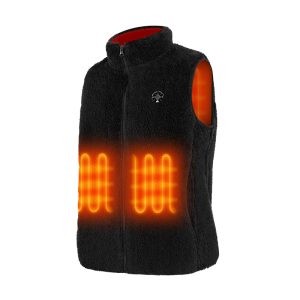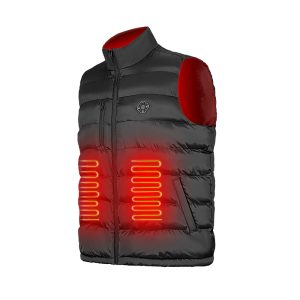When the cold season arrives, a rechargeable heated vest offers a practical and comfortable solution to stay warm without layering up too heavily. This guide walks you through everything you need to know — how these vests work, how to choose one, how to maintain it — so you can pick the best fit for your needs.
What Is a Rechargeable Heated Vest?
Table of Contents
ToggleA rechargeable heated vest is a garment embedded with heating elements (often carbon fiber or conductive wire) powered by a removable lithium-ion battery. The heating zones are usually placed around the chest, back, and sometimes the collar or side panels. You can turn on/off and adjust heating levels (low / medium / high), and the vest warms your core without adding bulk.
This hybrid design blends passive insulation with active heating, giving you flexible control over warmth. As noted in product examples like the N-Ferno 6495 vest, the heating zones may cover chest, back, and collar with multiple wattage settings.
Why Use a Heated Vest? Benefits & Use Cases
- Core warmth without restricting movement
Because arms are free, you retain mobility — great for outdoor activities, sports, workwear. - Energy efficiency & targeted heating
You only power the areas you need, instead of heating your entire body with heavy layers. - Versatility across seasons
Wear it over a base layer in moderate cold or under a jacket in extreme cold. - Longer comfort in freezing temps
High-quality vests can run for 6+ hours (on lower settings). - Reduced bulk & weight
Lightweight models make it easier to pack or layer.
Fieldsheer’s buyer guide mentions that the best vests use rechargeable batteries over disposable ones, and heating layout is a key differentiator among models.
Key Factors to Look for in a Heated Vest
To choose well, pay attention to:
| Factor | Why It Matters | Good Target / Note |
|---|---|---|
| Heating Zones & Layout | More zones → more even warmth | 4–6 zones covering chest, back, collar |
| Battery Type & Capacity | Determines runtime and portability | 5,000 mAh to 10,000 mAh; 5V, 7.4V, or proprietary |
| Heat Levels / Control | Flexibility for different temperatures | At least 3 levels (low / medium / high) |
| Safety Protections | Prevent overheating or electrical faults | Overheat protection, thermal cutoff, short-circuit guard |
| Fit & Fabric | Comfort and heat delivery | Slim fit, stretch panels, wind/water resistance |
| Washability & Maintenance | Real-world usability | Removable battery, machine-washable (gentle cycle) |
| Warranty & Brand Support | Reliability over time | Good warranty and spare parts availability |
According to a review in Travel + Leisure, one common mistake is neglecting how fast a vest drains battery on high settings — runtime can decrease drastically.
How to Use & Operate a Heated Vest
- Charge the battery fully before first use
Many batteries carry a few red/blue LEDs to show charge level; full charge often indicated by all lights steady (not blinking). - Insert battery and connect the vest wiring
Most vests include a pouch or internal pocket for the battery and a connector cable. - Power on & select heating level
Press and hold a power button (often ~3 seconds) to activate. Cycle through low / medium / high. - Let it preheat, then adjust
Some vests automatically shift from a boost mode to medium. - Monitor usage & switch levels as needed
Use lower settings when ambient temp is mild to save battery. - Turn off & disconnect battery when done
From an AKASO heated vest user manual: connect the USB plug, press & hold ~3 seconds to turn on/off, and shift through heating levels. Always disconnect and remove the battery before washing.
Tips for Care & Maintenance
- Always remove the battery before washing.
- Use a laundry bag and gentle wash cycle (cold water).
- Hang dry, avoid twisting, wringing, ironing, or dry cleaning.
- Store battery in a cool, dry place; recharge occasionally if unused for long periods.
- Avoid exposing the vest or battery to heavy rain or submersion.
Safety Considerations
- Don’t wear over bare skin — use a base layer.
- If you have sensitivity to heat, medical devices, or circulatory conditions, consult a physician before use.
- Stop using immediately if you feel discomfort or localized overheating.
- Use only the battery and charger specified by the manufacturer to avoid risks.
Example Products & Illustrations
- N-Ferno 6495 uses a 7.2V / 5000 mAh battery; offers 2.5 hrs on high, 5 hrs on medium, and 9 hrs on low.
- 32 Degrees Rechargeable Heated Vest features 4 heating zones, 3 heat settings, and about 6 hours of heat per charge.
These examples show typical tradeoffs: more battery capacity adds weight; more zones consume more power; higher voltage can improve heating speed but costs more.
Integrating NRheat / Your Brand (Optional Section)
If your brand or manufacturer nrheat.com is involved, here’s how you can weave in your narrative:
- Describe your heating technology (graphene, carbon fiber, etc.) and how your design optimizes energy efficiency.
- Highlight your safety standards and testing protocols.
- Mention custom OEM work (if nrheat produces for others) — it adds authority.
- Provide links to product pages or case studies.
For example:
“At NRheat, we tailor the layout of heating zones and refine the power control algorithms to balance warmth with battery efficiency. Many top vests in 2025 are built using NRheat’s core modules and safety systems.”
Frequently Asked Questions (FAQ)
Q: How long will a heated vest last on one charge?
A: It varies by battery size and heat setting. On low, many vests can run 6–10 hours; on high, 2–4 hours is common. Refer to manufacturer specs.
Q: Can I wear it in light rain or snow?
A: Some vests are water-resistant, but avoid heavy rain. Never submerge the vest or battery.
Q: Does it cost much to run?
A: Very little. Charging a battery (e.g. 10,000 mAh) consumes a small watt-hour amount from your electric bill.
Q: Can I replace the battery later?
A: Yes — many vests come with spare or replacement
Conclusion
A rechargeable heated vest is a smart investment for cold weather — giving you core warmth, flexibility, and control over your comfort. Use this guide to understand how they work, what features matter, how to use and maintain them, and how your own brand (or a manufacturer like NRheat) can fit into that story.







